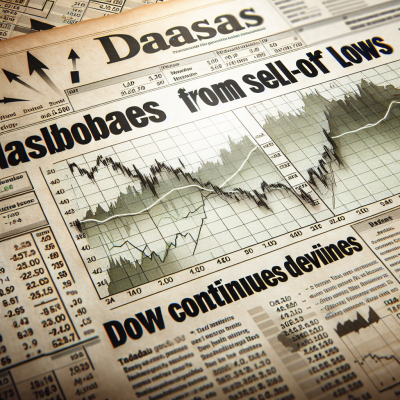
Stock Market Volatility: Nasdaq Rebounds While Dow and S&P 500 Decline
The stock market remained turbulent as the Nasdaq managed to recover from its recent lows, while the Dow Jones Industrial Average and the S&P 500 extended their declines. This movement comes amid continued recession fears and market uncertainty, keeping investors on edge and prompting caution in trading decisions.
Market Performance Overview
Markets opened the week with notable losses, keeping investors wary of upcoming economic data and Federal Reserve actions. The Nasdaq showed resilience, bouncing back slightly after last week’s sell-off, while the S&P 500 and Dow struggled to gain traction.
Key highlights from the market movement include:
- Nasdaq Composite: Managed to climb back from its sell-off lows, showing some signs of stability amid ongoing pressures.
- Dow Jones Industrial Average: Continued its downward trend as investors weighed economic uncertainty and global financial conditions.
- S&P 500: Extended its losses alongside the Dow, reflecting ongoing investor caution.
What’s Driving the Market Decline?
Several factors continue to contribute to market instability, including macroeconomic concerns, monetary policy shifts, and global financial trends.
Recession Fears on the Rise
Investors remain concerned about a potential economic slowdown as inflationary pressures persist. Recent economic reports have presented a mixed picture, leading to uncertainty about future growth. The Federal Reserve’s stance on interest rates has also fueled market jitters.
Federal Reserve Policy and Interest Rates
The Fed has maintained a cautious approach in response to inflation concerns, leaving investors wondering whether further rate hikes are possible. While some analysts believe the central bank has reached its peak in tightening, others anticipate additional adjustments could come later this year.
Corporate Earnings and Market Response
As earnings season unfolds, investors are keeping a close eye on corporate performance and guidance. Several companies have reported earnings surprises, both positive and negative, influencing overall market sentiment. Tech stocks, in particular, have seen mixed results based on earnings reports.
Investor Sentiment and Market Outlook
Investment sentiment remains fragile as traders weigh risks in the current economic environment. Some investors are looking for buying opportunities as stocks dip, while others hesitate, waiting for clearer indications of the market’s direction.
Despite ongoing challenges, the market has shown resilience at key support levels. Analysts suggest that additional economic data and Federal Reserve signals will be key in determining future market movements.
What Should Investors Do Next?
In times of volatility, strategic planning is crucial. Here are a few considerations for investors:
- Diversification: Maintaining a well-diversified portfolio can help mitigate risks.
- Focus on Fundamentals: Evaluating company fundamentals rather than reacting to short-term market swings is essential.
- Monitor Economic Reports: Keeping an eye on key economic indicators can offer insights into market trends.
Final Thoughts
The stock market’s recent performance highlights continued volatility and uncertainty. Nasdaq’s recovery from sell-off lows provides some optimism, but the broader market’s struggles signal caution. As economic concerns persist, investors will need to stay informed and adaptable in the face of fluctuating market conditions.
Looking ahead, Federal Reserve updates, corporate earnings, and economic data will remain crucial factors shaping market direction. Investors should remain vigilant and make informed decisions as they navigate an unpredictable financial landscape.


Leave a Reply